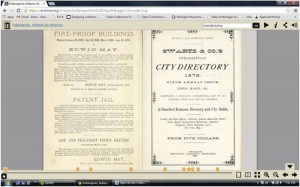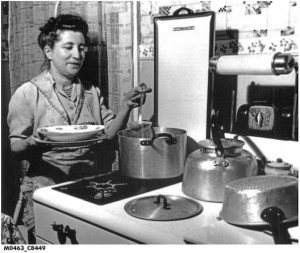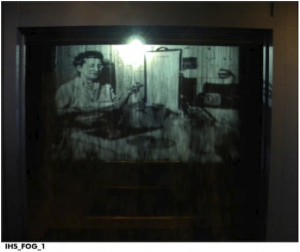Surfing with purpose: Online collections as exhibit resources (Part 1)
20 August 2014 – Theresa Koenigsknecht

Digital collections like those of the Internet Archive have drastically expanded the resources available to exhibit creators. Photo credit: Internet Archive
Thanks to the exponential increase in availability of digitized collections, possibilities in exhibit research have drastically expanded. Digital collections have become essential tools that help ensure the success of projects with limited budgets and tight deadlines, which most public historians might agree is just about every project. At the same time, it is often overwhelming to sift through the wide range of options. How can researchers, curators, and designers best utilize and understand the many resources provided through digital repositories and open access collections?
I recently responded to a tweet by Mary Rizzo asking for examples of people using the Internet Archive, an open access digital collection, in their public history work, and she suggested I write a blog post about using tools like this. As an Exhibitions Researcher at the Indiana Historical Society, my initial reaction was to think “I don’t know much about open access collections, I just use them.” Considering again, however, I realized that even though I was trained during the era of digitization and I use these resources as second nature in my work, I’ve still gone through a learning process in my job. While the realm of online collections can be intimidating, there are basic online resources that can greatly benefit researchers. Below I will discuss several different digital repositories and how IHS uses them to find high-quality free images that add context and complexity to our exhibits.

This original image of Holocaust survivor Frania Kaplan in her Indianapolis kitchen was used in the Indiana Historical Society’s “You Are There” series “1950: Making a Jewish Home.” Photo credit: Indiana Historical Society

The photo was projected through a fog screen that visitors stepped through to “enter” 1950. Photo credit: Indiana Historical Society

Once inside, visitors interacted in the recreated kitchen with trained interpreters. Photo credit: Indiana Historical Society
In our department at IHS, we are responsible for generating content for a variety of exhibits. In researching our more traditional exhibits, I spend the majority of my time looking for historic and modern-day images. Although I begin my initial research within the IHS collection and other local and statewide repositories, digitally accessible collections provide the majority of my primary sources. In our main galleries, our “You Are There” exhibits pose even more of a research challenge.
In the YAT experience, our exhibits and design team recreates an image from the IHS collection as a physical space that visitors are invited to enter. Visitors literally step inside a projected historical image and experience a strong sense of stepping into the past. Once inside, period appropriate details from the photograph are recreated and all items in the spaces are hands-on. Actors inside the space bring to life the people depicted in the photographs and others who, based on research, could have been present on a given day. Meticulous research is required to create a historically authentic space. In any given day I may need to find census data for characters, city directories or Sanborn maps, and period-appropriate props.
Technically, collections under “open access” allow users unrestricted access and reuse of materials. These types of sources are also often labeled as being in the “public domain.” Collections that are accessible digitally but still have copyright restrictions typically cannot be used without permission but are still very convenient. In my work particularly, I rely heavily on open access collections to find affordable images and primary sources.
Helpful databases for primary resources:
Internet Archive is a non-profit digital library, and it is one of our “go to” tools. You can find text, audio, video, and even a “Waybackmachine,” which has 410 billion web pages saved over time.
My favorite thing about this database is that many items are indexed. I can save so much time by searching for a phrase or word before deciding if a source is worth investigating. For example, to find the source pictured at the top of this post, I searched for “Indianapolis City Directory.” After choosing 1876, I then searched for “manufacturing,” and the results appear as points below the text. Without searchable digital versions of sources like this, I might need to instead take a trip to a local repository and painstakingly comb through rolls of microfilm.
Beyond the Internet Archive, other useful online repositories include:
Project Gutenberg: Was one of the first producers of free-to-use ebooks and has many rare publications which are also text searchable.
Harvard University Library Open Collections Program: Offers six subject-specific, web-accessible collections linking diaries, letters, images, and other materials by theme.
The Library of Congress American Memory: Includes collections of written and spoken words, sound recordings, still and moving images, prints, maps, and sheet music documenting the American experience.
Part 2 follows.
~ Theresa Koenigsknecht is an Exhibitions Researcher at the Indiana Historical Society. Follow her on Twitter @TKhistarch7.




1 comment